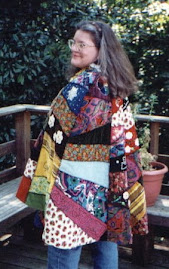Now the fun part begins! Today I'm adding the roses to my frieze.
I'm using Plaid's Decorator Blocks. I'm not sure if they still make them, but they can usually be found on
ebay. They no longer make the glaze paint for them.
You can see an article about this product on Plaid's web page:
http://www.plaidonline.com/apDB.aspSince the glaze paint is no longer available, I had to devise my own. Here are the tools I took with me up the ladder:

In my tray, I have two brushes, one to load the red paint, one for the green.
The paints are
Liquitex Glazing Medium, Plaid Folk Art #958 Christmas Red, Plaid Folk Art #924 Thicket, and Plaid #901 Wicker White.
I also have a small cup of water, pa
per towels, and Plaid Decorator Blocks. The blocks are Plaid's # 53211 Roses Roses.
The pallet is a simple
foam plate.
Each block is a foam stamp cut in the shape of part of the design. There are 3 leaves, 1 open rose, 1 partially open bud, and 1 small bud.
Put a small amount of glaze medium, green paint, and red paint on the pallet. (Once I began, I decided to not use the white paint.)
To begin, dip a slightly damp brush into the glaze medium, then into the paint. Mix them together on the brush. Then apply the paint to the Decorator Block.

Apply the block to the wall, and press firmly. Remove, choose another location, and press the block to the wall again. Each impression will be somewhat lighter than the previous one.
I'm glad I took my own advice, and started on the least obvious wall. I think this first part looks too heavy and over worked.

I like the second wall much better.

This is a close up of the second wall.

The first ten feet took about two hours. It should speed up a bit as I progress around the room. I have to take a break about every two hours...that's about as long as I can hang off the ladder at one time.
After I've done all the stamping, I'll go back with a liner brush and paint a few stems and tendrils.
Later I'll be adding other elements...fairies, dragonflies and birds are the current contenders.

















